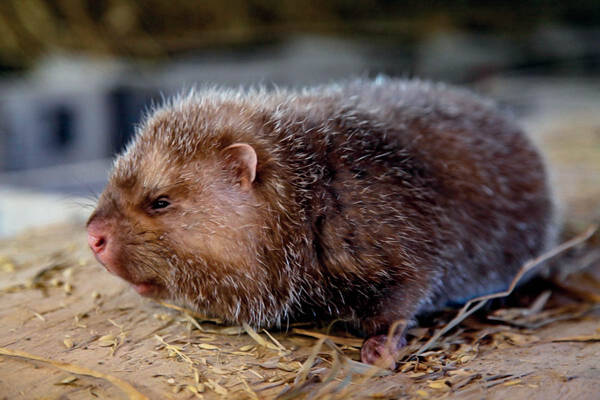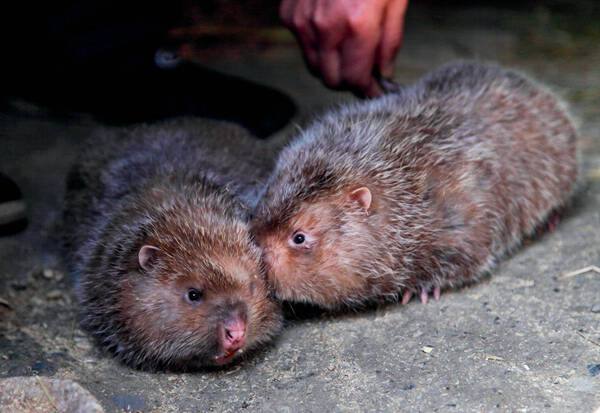Rhizomys sinensis Gray
IUCN
LCBasic Information
Scientific classification
- name:Rhizomys sinensis Gray
- Scientific Name:Rhizomys sinensis Gray, bamboo rat, bamboo pig, bamboo civet, bamboo civet, bamboo weasel, reed rat, reed rat
- Outline:Rodents
- Family:Rodentia Rhizomysidae Rhizomys
Vital signs
- length:28-30cm
- Weight:1.8-3kg
- lifetime:
Feature
It has a mole-like body, a stout appearance, similar to a zorrat, and dense, soft, brown-gray fur.
Distribution and Habitat
In China, it is more widely distributed than the silver-star bamboo rat. In addition to being widely distributed south of the Yangtze River, it is also distributed in most parts of Sichuan, Gansu and Shaanxi. Abroad, it is distributed in Myanmar and Vietnam.
Chinese bamboo rats mostly live on hillsides. In the Qinling Mountains, they often live in mid-mountain broad-leaved forests and coniferous broad-leaved mixed forests above 1,000 meters above sea level. There are many bamboo plants under the forest, or they live directly in bamboo forests.
Appearance
Compared with the silver-star bamboo rat, it is slightly larger, weighing 1800-3000g. The average body length is about 280mm. The body is stout, with dense and soft fur. The fur on the back is gray, without long white guard hairs, so the overall tone is not silver-gray, but gray. The tips of the fur on old individuals are slightly brownish-yellow. However, the distal ends of the guard hairs of subadults and juveniles are grayish-white, so they also appear grayish-white. The ears protrude from the fur and can be seen from the outside, but the ear height is the same as that of the silver-star bamboo rat, less than 20mm. The tail is naked and hairless, with a length of less than 150mm. The skull is strong and thick, with a high and slanted occipital bone, powerful incisors that point vertically downward, and an orange lip.
Details
Like the silver-star bamboo rat, the Chinese bamboo rat is also a member of the subfamily Rhizomyinae. It lives underground for life and feeds on bamboo whips and bamboo shoots. It is distributed in Sichuan, Shaanxi and Gansu, and is co-existing with giant pandas. When the population is large, it will cause bamboo to die in large areas, competing with giant pandas for food. Individuals are large and delicious, and have been raised in large numbers, with 2-6 cubs per litter.

Chinese bamboo rats live in caves, hiding during the day and coming out at night. They like to live in a quiet, clean, dry, well-lit, and fresh air environment. They are gentle, male and female are inseparable, and have strong resistance to adversity. The suitable living temperature is 8~40℃, and the optimal temperature is 11.7~28.5℃.
Chinese bamboo rats are herbivorous animals that can eat the rhizomes of various bamboos, sugar cane, corn, etc. and the seeds and fruits of grass-root plants. When there is a lack of food, it also harms crops.
The burrows of Chinese bamboo rats are very complex, and the burrows of adults are more complex than those of young ones. Hunters often judge the size of bamboo rats based on feces, footprints, the size of the burrows, and the complexity of the burrows. Burrows generally include earth mounds and burrow entrances, feeding ducts, nests, and shelters.
Earth mound and hole entrance: When digging a hole, the Chinese bamboo rat pushes out the soil, forming an earth mound on the ground, and under the earth mound is the hole entrance. Whether there is a bamboo rat in the hole can be determined by whether the soil in the earth mound is fresh. If the earth mound is dry, or it is covered with bamboo leaves or tree leaves, or moss and other plants grow on it, it can be determined that there is no bamboo rat in the hole. Whether there is a bamboo rat in the hole can also be determined by checking whether there are traces of bamboo bitten by bamboo rats around the hole entrance. If there are fresh traces of bitten bamboo around the hole entrance, it can be determined that there is a bamboo rat.
Feeding canal: The feeding canal is the passage for bamboo rats to eat and move. They gnaw on the bamboo roots and unexcavated bamboo shoots around the burrows, drag the bamboo into the burrows and bite them into small sections, and then gnaw them slowly. The feeding canal is parallel to the ground surface, 14~25cm from the ground surface. Five burrow systems were dissected in Liuba County: the feeding canal has 1~2 branches, unlike the Chinese bamboo rats distributed in Yunnan, which have 4~7 branches. The length of the feeding canal is about 10m, which is not as long as the bamboo rat burrows in Yunnan. The total length of the Chinese bamboo rat burrows in Yunnan can reach 55m, which may be related to the environment. The feeding canal of bamboo rats is smooth and moist, but there is no water accumulation.
Nest: The nest is the residence of the Chinese bamboo rat and also the place for giving birth and raising young. It is located on the feeding canal and is wider, larger and higher than the feeding canal. The nest length × width × height = (34~38) cm × (20~32) cm × (19~25) cm. The inner pad is filled with bamboo joints, bamboo leaves, bamboo twigs and bamboo silk bitten by bamboo rats. There is no fixed toilet, and the feces are discharged 10~25cm away from the nest. The feces are blunt at both ends, like medicinal capsules, dark green in color, hard in texture, and the size is: length × diameter = (19~25) cm × 9mm.
Refuge hole: The refuge hole is a safe hole for Chinese bamboo rats to escape from enemies. The bamboo rats are usually caught in the refuge hole when digging holes. Moreover, people dig outside, and the bamboo rats inside block the hole and dig forward. The refuge hole is 2~5m long, and some can reach more than 3m, and the depth from the ground is 70~170cm. The direction of the refuge hole is deep underground.

There are always traces of bamboo bitten around the holes of bamboo rats in the wild, indicating that bamboo rats often go out of the holes, bite off the bamboo near the ground, and then drag the bamboo stalks together with the branches and leaves at the end into the hole. Give the bamboo rat a long bamboo, it will first bite it into several sections with its incisors, and then hold it with its two front fingers and palms to chew. The bamboo is cut by the incisors, with the upper incisors as the fixed point, and the lower incisors repeatedly cutting in one direction until the bamboo is cut; if the bamboo cannot be cut, the upper and lower incisors will be rubbed against each other quickly, and then the bamboo will be cut again. When chewing the bamboo joint, the front fingers will hold the bamboo joint up and down, with the head slightly tilted to the side, the upper incisors are still the fixed point, and the lower incisors will scrape and bite repeatedly from bottom to top for more than ten times, making a rapid tooth collision sound, and then chewing quickly, and chewing the bamboo joint repeatedly in this way. During the chewing process, teeth grinding behavior will also occur.
Nutritional value
Bamboo rat meat is delicate and lean, delicious and tasty, and is a top-grade game. It is a meat food with high nutritional value, low fat and low cholesterol. The nutritional composition of bamboo rat meat is determined to contain 57.78% crude protein, 20.54% crude fat powder, 17.36% carbon, 0.84% crude fiber, 3.84% water, and is also rich in P, Ca, vitamin E and amino acids. The content of lysine, leucine and methionine is higher than that of chicken, duck, goose, pig, cattle, sheep, fish, shrimp and crab.
Medicinal effects
Bamboo rats can also be used as medicine to treat diseases. The Compendium of Materia Medica says that it has special effects such as "regulating menstruation, protecting hair, replenishing blood and qi, nourishing yin and strengthening yang". Modern medicine has also proved that bamboo rat meat can promote the growth of human white blood cells and hair, enhance liver function and prevent vascular sclerosis. In particular, bamboo rat meat is rich in collagen, which is a kind of gelatinous organic matter composed of biological macromolecules. It is the most important protein component of human skin, tendons, tendons, teeth and bones, accounting for about one-third of the total protein in the human body and is a nutrient that muscles must take in. Taking collagen from bamboo rat meat can promote human metabolism, reduce the decline of cell plasticity, enhance skin elasticity, prevent skin dryness, atrophy, wrinkles, etc., improve the physiological functions of various organs of the body, and resist aging. The liver, gallbladder, meat, and bones of bamboo rats can be used directly as medicine to treat physical weakness and fear of cold, lumbar cold pain, impotence and premature ejaculation, weakness after postpartum illness, neurasthenia, insomnia, joint and tendon pain, etc. At the same time, bamboo rat serum soaked in wine has special effects on the treatment of bronchial asthma and diabetes.
In addition, bamboo rat meat is a tonic that is beneficial to health and beauty. The fur of bamboo rats is soft, shiny, and thick, and is a high-quality raw material for making fur coats. Jackets and long coats made from its skin are extremely popular in the international market. Bamboo rat whiskers are the raw material for making high-end brushes, and the supply is tight and in short supply.
Bamboo rats have very high medicinal value. The bones and blood of bamboo rats are used to make medicinal wine to treat rheumatism, bronchitis, asthma and diabetes. Regular consumption can enhance the body's resistance and immunity. Its oil can prevent mosquito bites, treat burns and scalds, and beautify. In addition, breeding bamboo rats can provide medicinal matrix and raw materials for the development of new drugs.








